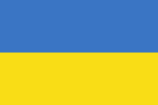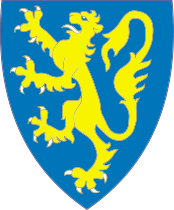West Ukrainian People's Republic
|
|||||||||||||||||||||||||||||||||||||||||||||||||||||||||||
The West Ukrainian National Republic (Ukrainian: Західно-Українська Народна Республика, Zakhidno-Ukrayins’ka Narodna Respublyka or ЗУНР, ZUNR; also translated "West Ukrainian People's Republic") was a short-lived republic that existed in late 1918 and early 1919 in eastern Galicia, that claimed parts of Bukovina and Carpathian Ruthenia and included the cities of Lviv (Polish: Lwów), Przemyśl (Ukrainian: Peremyshl), Kolomyia (Polish: Kołomyja), and Stanislaviv (Polish: Stanisławów).
The coat of arms of the West Ukrainian People's Republic showed a yellow lion against a blue background looking to the left. The colors of the flag were blue and yellow.
Contents |
History
According to the Austro-Hungarian census of 1910, the territory claimed by the West Ukrainian People's Republic had about 5.4 million people. Of these, 3,291,000 (approximately 60%) were Ukrainians, 1,351,000 (approximately 25%) were Poles, 660,000 (approximately 12%) were Jews, and the rest included Germans, Hungarians, Romanians, Czechs, Slovaks, Romani, Armenians and others. The cities and towns of this largely rural region were mostly populated by Poles and Jews, while the Ukrainians dominated the countryside. This would prove problematic for the Ukrainians, because the largest city, Lviv (Lwów, Lemberg), had a majority Polish population and was considered to be one of the most important Polish cities. Conflict between the West Ukrainian People's Republic and Poland was thus inevitable.
The West Ukrainian People's Republic was proclaimed on November 1, 1918. The Ukrainian National Rada (a council consisting of all Ukrainian representatives from both houses of the Austrian parliament and from the provincial diets in Galicia and Bukovina) had planned to declare the West Ukrainian People's Republic on November 3, 1918 but moved the date forward to November 1 due to reports that the Polish liquidation committee was to transfer from Kraków to Lviv.[1] Shortly after the republic proclaimed independence from the Austro-Hungarian Empire a popular uprising took place in Lviv, where most residents were Polish and did not want to be part of a non-Polish state. A few weeks later Lviv's rebellious Poles received support from Poland.
The government of the Western Ukrainian People's Republic united with the Ukrainian People's Republic on January 22, 1919, although this was mostly a symbolic act because the western Ukrainians retained their own Ukrainian Galician Army and government structure. After the Polish-Ukrainian War, Poland took over most of territory of the West Ukrainian People's Republic by July 1919. Part of the defeated army found refuge in Czechoslovakia and became known there under the name Ukrajinská brigáda (in Czech), while most of the army, consisting of about 50,000 soldiers, crossed into the territory of the Ukrainian People's Republic and continued the struggle for Ukrainian independence there. In 1920 Poland and Ukraine agreed to a border on the river Zbruch.
| History of Ukraine |
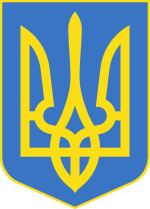 This article is part of a series |
|
Trypillian–Cucuteni culture
Yamna culture Catacomb culture Cimmeria Taurica Scythia Sarmatia Zarubintsy culture Chernyakhov culture Hunnic Empire |
|
Cossacks
Polish–Lithuanian Commonwealth
Zaporozhian Host Khmelnytsky Uprising The Ruin Cossack Hetmanate Left bank Sloboda Ukraine Right bank Danube |
|
Early Modern Period
|
|
Early Twentieth Century
Ukraine during World War I
Ukraine after the Revolution Ukrainian Civil War Ukrainian People's Republic West Ukrainian People's Republic Ukrainian State Directorate of Ukraine |
|
Topics
Name of Ukraine
Historical regions Christianity in Ukraine |
|
Ukraine Portal |
Government
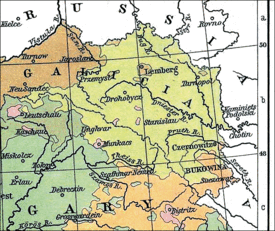
The West Ukrainian People's Republic governed an area of approximately 4 million people for much of its eight-month existence. Elections on Ukrainian-controlled territory were held from November 22–25 for the 150-member Ukrainian National Council that was to serve as the legislative body. Approximately one-third of the seats were reserved for the national minorities (Poles, Jews, Slovaks and others). The Poles boycotted the elections, while the Jews participated and were represented by about 10 percent of the delegates. Yevhen Petrushevych, the chairman of the Council and a former member of the Austro-Hungarian parliament, automatically became the Republic's president. Despite the war, the West Ukrainian People's Republic maintained the stability of the pre-war Austrian administration intact, employing Ukrainian and Polish professionals. The boundaries of counties and communities were kept the same as they had been during the time of the Austro-Hungarian Empire. The county, regional, and local courts continued to function as they had while the country had been a part of Austria. Austrian laws remained temporarily in force. Likewise, the government generally retained the Austrian system of tax collection, although war losses had impoverished the population and the amount of taxes collected was minimal. Most of the government's revenue came from the export of oil and salt.
On February 15, 1919, a law was passed that made the state language Ukrainian. According to this law, however, members of national minorities had the right to communicate with the government in their own languages. The Western Ukrainian People's Republic also passed laws that confiscated vast estates from private landlords and distributed the land to landless peasants. It divided the territory of the West Ukrainian National Republic into 12 military districts whose commanders were responsible for conscripting soldiers. The government was able to mobilize 100,000 soldiers in the spring of 1919, but due to a lack of military supplies only 40,000 were battle-ready.
In general, the government of the West Ukrainian National Republic was orderly and well-organized. This contrasted with the chaotic state of the Ukrainian governments that arose on the territory of the former Russian Empire.
Postage stamps
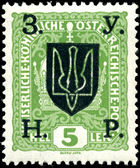
The republic issue about one hundred types of postage stamps during its brief existence, all but two of which are overprints on existing stamps of Austria or Bosnia.
See also
- Galician Soviet Socialist Republic, revolution government installed by Soviet Russia in 1920
References
- ↑ Encyclopedia of Ukraine, vol. 5, 1993 entry written by Andrzej Chojnowski
- John Bulat, Illustrated Postage Stamp History of Western Ukrainian Republic 1918–1919 (Yonkers, NY: Philatelic Publications, 1973)
- Kubijovic, V. (Ed.), Ukraine: A Concise Encyclopedia, University of Toronto Press: Toronto, Canada, 1963.
- Subtelny, Orest (1988). Ukraine: A History. Toronto: University of Toronto Press. ISBN 0-8020-5808-6.
- Paul Robert Magocsi, A History of Ukraine, University of Toronto Press: Toronto 1996, ISBN 0-8020-0830-5
